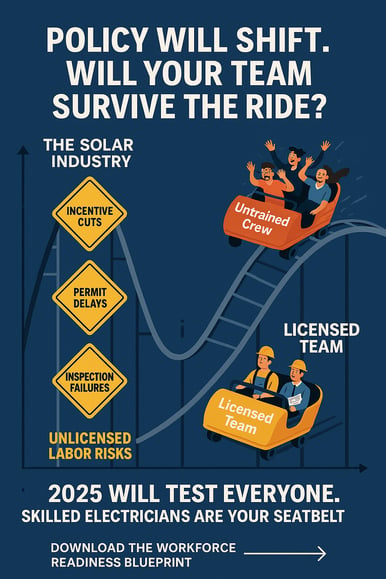The Solar Coaster Is Back: Only the Skilled Will Survive 2025

The solar industry is bracing for impact.
With a new administration stepping in, fear is rippling through the renewable sector, uncertainty around tax credits, utility policies, and solar-friendly incentives is already causing contractors and solar companies to freeze up.
But here’s the truth no one wants to admit: this was always coming.
We’ve been here before, and every time, only one type of business survives: the ones who’ve invested in skilled, licensed electricians and built a real workforce.
This isn’t the time to wait it out or hope for favorable policies. This is the time to double down on the one thing that outlasts politics: your people.
In this article, we break down: Why this “solar coaster” moment feels different (and how it’s not) What’s at stake if you rely on unlicensed labor or temp crews How to build a team that doesn’t just survive but dominates in uncertain markets
The Solar Coaster is Real & It’s Back
The term 'Solar Coaster' aptly describes the nature of the solar industry. Over the years, we’ve seen periods of rapid growth followed by abrupt slowdowns, driven by fluctuating incentives, permitting delays, and code updates. These cycles are not just an industry quirk, they're a fundamental characteristic, and they tend to weed out unprepared players.
With new leadership poised to reshape policy priorities, we're staring down another wave of regulatory and market shifts. The contractors and businesses that fail to prepare will find themselves struggling to stay afloat. The smart move? Embrace the inevitability of change and prepare for it.
Why Education and Licensing Are the Lasting Advantage
In today’s solar industry, the days of untrained or underprepared labor are long gone. Increasing scrutiny on installations, including compliance with the National Electrical Code (NEC), Authority Having Jurisdiction (AHJ) inspections, fire codes, and grid integration, means that only the most skilled teams can ensure quality and safety.
The distinction between casual 'installers' and licensed, trained electricians has never been more pronounced. Licensed electricians bring a level of expertise and reliability that can make or break a project, especially in a volatile market. Investing in education and licensing is not just a regulatory requirement, it's a strategic advantage.
How to Withstand the Turbulence: Build from Within
To navigate the ups and downs of the solar coaster, businesses need to build resilience from within. Apprenticeship programs are a crucial component of this strategy. By developing skilled workers internally, you create a pipeline of talent that's tailored to your specific needs.
Retention through upskilling is another key strategy. Investing in your existing team’s development not only enhances their skills but also fosters loyalty. This approach is far more sustainable than continually recruiting and training new hires every few months. Licensed journeymen and foremen can provide the stability and expertise needed during uncertain times, ensuring that your projects stay on track and meet all regulatory standards.
Navigating Solar Policy Changes
Policy changes are a constant in the solar industry. Whether it's shifts in tax credits, utility policies, or other solar-friendly incentives, staying ahead of these changes is crucial. Businesses that can quickly adapt to new regulations will have a significant edge over those that can't.
To navigate these changes effectively, it's essential to stay informed and engaged with industry developments. This means not only understanding the current landscape but also anticipating future trends. By preparing for policy shifts in advance, you can mitigate their impact on your operations and continue to thrive.
The Long-Term Play: Building a Future-Proof Workforce
The ultimate goal is to build a future-proof workforce. Educated electricians can adapt more quickly to technological advancements, policy changes, and evolving safety standards. A trained workforce builds brand trust, passes inspections more consistently, and reduces rework costs, which directly impacts your bottom line.
This isn’t just about surviving the current cycle, it's about positioning your business to dominate the next wave of demand. By investing in workforce development now, you ensure that your team is prepared for whatever the future holds.
This proactive approach will set you apart from competitors who are merely reacting to market changes.
